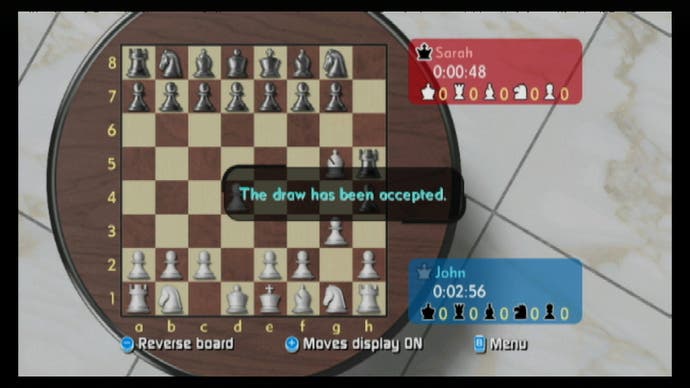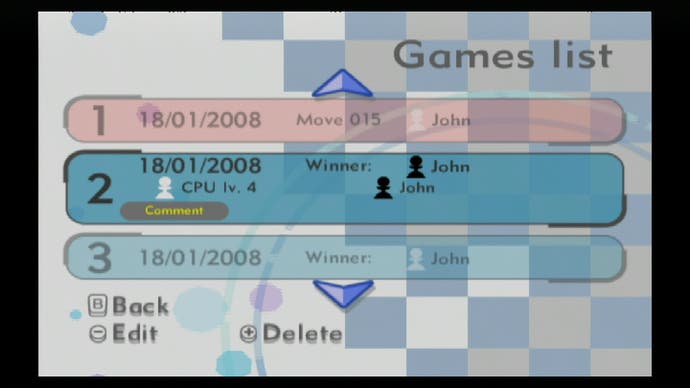Wii Chess
King me.
You might find it surprising that Nintendo went out and found a competition-standard chess program to build its budget-price Touch Generations chess game on. I didn't. What I found surprising was that it built the game around the loop chess engine, which came a pathetic third in the 2007 Amsterdam ICGA Tournament. What's wrong, Nintendo? Rybka's UCI chess engine a bit too expensive for you? I thought you played to win these days?
What I also found surprising - and a bit disappointing - is that you can't put your Miis into Wii Chess, or customise chess sets in any way. A puzzling oversight given all the money they saved only getting the third-best chess engine in the world to power the computer players. My carefully staged plans for a Eurogamer chess set with me as king, Ellie as queen and Bertie as the bishop behind a row of Dans who put the screenshots up are now useless.
Slightly less surprising is that you don't actually control the game by standing up waving the Wiimote around. In fact, the pointer isn't used at all. You control the game one-handed, selecting pieces with the A button and moving them with the d-pad. Pressing B when you're holding a piece cancels the move, and pressing B at other times brings up a menu allowing you to quit, give up, receive a hint, cancel the last move, save your game and so on. When you highlight a piece, the game also shows you its potential movements (although you can turn this off).

Elsewhere on the screen, you're shown a timer for each player to keep track of how long you're both taking, and you can also get a readout of recent moves on the side in chess-speak, which makes you look quite intelligent to passers-by or if you leave your curtains drawn and there's a man with a telescope. What will look less intelligent is if you use one of the unlockable chess-set designs that makes the board look like a football pitch, or if you name your profile "Deep Poo".
The good news for single players is that even the world's third-best chess engine has some serious game, as they say at the Fédération Internationale des Échecs. There are ten levels of difficulty for you to play against on your own, and, while I breezed past the first couple, even someone as amazingly tactically astute, patient and inventive as I am couldn't overcome the higher ones (alright, the middle ones). The ICGA - the International Computer Games Association - isn't about whether you're any good at Mario Kart, you see, it's about making software to "solve" games like chess and Go, and while I'm hardly a grand master I'd be surprised if the average punter ever throws this one out for being too easy.
Anyway, I appear to have been surprised to some degree in every paragraph so far, so while I calm down let's talk about what it's like to play with other people. Offline, you can play against another person, with the same controls. It's like playing chess. You can't cheat, and the game warns you if you're doing something illegitimately suicidal (i.e. moving yourself into check). Obviously you can see what the other person is considering doing, even if they rein themselves in, but then you can do that if you're sat opposite them too so it's not like they're looking at your screen in Quake or anything.

Online, though, is where this should shine. Hooking up to Nintendo Wi-Fi Connection is as easy and free as ever, and inputting friend codes is as time-consuming and stupid as ever, but at least the interface is sensible, and once you're set you can choose to play against a friend (with invites optional), anyone in the world, or someone of comparable skill. I went for the latter, fully expecting nobody to be playing it because it's chess, so the rate of player turnover will be low, but after 60 seconds or so of staring forlornly at the waiting screen I was matched with a player called "Guts". Hi Guts! Guts seemed like a good match for me, eventually triumphing after I got myself into a pickle. My subsequent opponents were pretty good too. You can play games where each of you has five minutes to make your moves, or games where you get 20 apiece, which seems like ample time for an online chess game - if you wanted to spread it out over hours, you'd probably be face to face anyway.
Sadly though, there's no correspondence chess option. Now, my Nanna has yet to be taken in completely by the suspiciously well-choreographed photo-calls and lifestyle articles in Healthy Nonagenarian about the amazing Nintendo Wii, but if she did have one then I doubt she would want to sit on the sofa playing a chess game where she couldn't speak to me at the same time for the best part of an hour, but she might very well do it if it only meant making one move a day. Given the Wii's built-in messaging system, it would seem like a good fit, too.

Final thing, then - if you genuinely fancy learning to play chess, having never bothered to do so, or you're just an amazing player who likes to understand why you lost to someone called Deep Poo, then the ability to save up to 20 finished games to look back upon later will come in handy. This analysis section of Wii Chess allows you to replay them completely with start and stop controls and other navigation tools.
"Analysis" seems like a good point to finish on. We obviously can't "review chess" and give it a score out of 10 in any sensible way, so the number below may well seem a bit arbitrary. It's a result of the following calculation: I like chess, Wii Chess has lots of sensible options, and the online play works, but it's missing a few things that would make it better, like voice comms, correspondence options and of course motion sensor controls for dangling a piece over a square and then putting it back down again. "Good", then, but whether you'd pay the best part of 20 quid for it is up to you.

